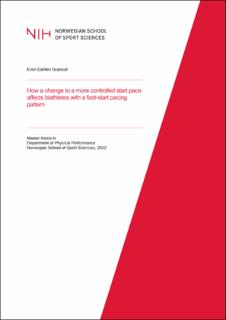| dc.description.abstract | Purpose: In sprint biathlon with 3 equal laps, the most used pacing strategy is parabolic with the first and last lap being the fastest. However, as the best biathletes tend to have a more even pattern than the rest of the competitors, our aim was to investigate whether competitive junior biathletes with a fast-start pacing pattern increase time-trial performance by use of a more even pacing strategy.
Methods: Thirty-five biathletes, male and female (~17.5 years) performed two biathlon races of 6780 meters on roller skis, separated by 24 hours. The race consisted of 2 prone shootings, with 2260 meters between shootings. On day 1 all participants were instructed to perform a self-paced race as fast as possible. On day 2, the half with the fastest relative start pace before first shooting (relative to their average lap time) were instructed to have a more controlled opening pace before the first shooting (Intervention group; INT). The remaining participants (Control group; CON) were instructed to replicate their pacing strategy from day 1.
Results: At day 2 compared to day 1, INT increased their time before the first shooting (mean ± 95% confidence interval; 1.8% ± 0.87%, p<0.001, effect size; ES = 1.0), but finished with a faster overall skiing time (-0.95% ± 0.82%, p<0.05, ES = 0.55). CON showed no change in skiing time before the first shooting (0.1% ± 1.0%, p=0.84, ES = 0.0) or overall skiing time (0.0% ± 0.9%, p=0,98, ES = 0.0). Despite INT’s improvement in skiing time, there were no significant difference in skiing improvement between groups (p=0.12, ES = 0.54). The summated Rate of Perceived Exertion (RPE) for the race as a whole were reduced for INT (p < 0.001). INT shot significantly better than CON on day 1 (p<0.05). INT had a significant lower total shooting score on day 2 (-5.8% ± 4.0%, p<0.05, ES = 0.74), and lower score for the first shooting (-6.9% ± 5.1%, p<0.05, ES = 0.72) compared to day 1. CON had no significant differences in neither summated RPE or shooting results between days (both p>0.05).
Conclusion: For junior biathletes with a fast start pattern, a change towards more controlled opening seems to lead to a faster skiing time and reduced summated RPE. This implies that such a strategy is beneficial for skiing performance and leads to less discomfort during the race. However, INT reduced shooting performance which implies that an acute change in start pace could influence skiing and shooting performance differently. | en_US |
